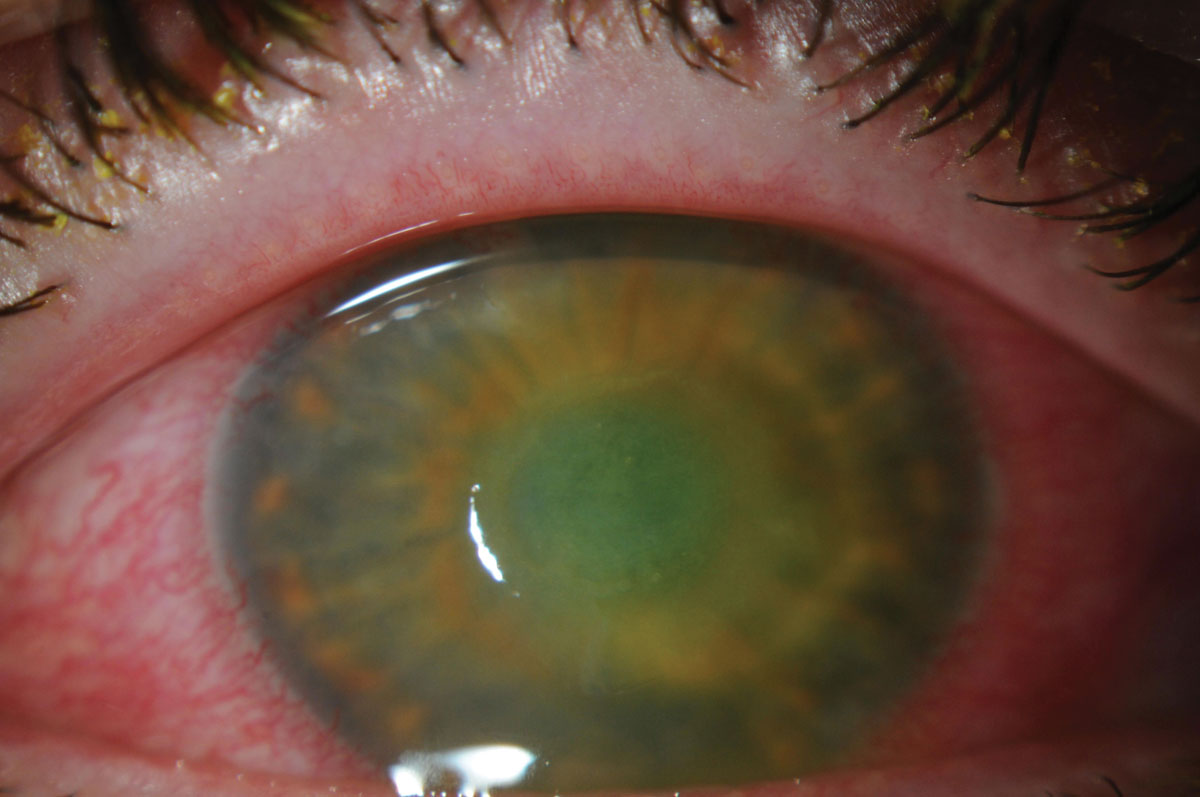 |
| Certain species of bacteria appear integral to maintenance of the ocular surface microbiome, with alterations leading to susceptibility of infectious keratitis development. Photo: Suzanne Sherman, OD. Click image to enlarge. |
Acute and potentially sight-threatening, infectious keratitis of the cornea can lead to permanent damage. It is the leading cause of monocular blindness worldwide. Corneal opacities, mostly the result of infectious keratitis, are the fourth leading cause of blindness globally. As such, researchers wanted to further study the wide range of microorganisms that can lead to alteration of the ocular surface microbiome of patients with infectious keratitis, specifically in an agricultural area of northwest China.
A total of 57 patients were included and divided into categories of bacterial keratitis, fungal keratitis, viral keratitis and healthy controls. All were collected for corneal scrapings, eyelid margin and conjunctiva samples, and DNA sequencing.
The study authors found that significant alterations to the microbiome existed between the keratitis groups and the control group. Also was an observed difference between eyelid margin and corneal scraping samples in the former. Overall, the species of Bacillus, Megamonas, Acinetobacter and Rhodococcu were elevated in keratitis patients while a depressed level of Staphylococcus was also observed in the keratitis group.
The abundance of the ocular surface microbiome was much higher in corneal scrapings with infectious keratitis than with eyelid margin samples. As well, there was greater abundance of ocular surface microbiomes in those with infectious keratitis, but the microbiome of those healthy controls was more diverse than those with bacterial and viral types, echoing the suggested dysbiosis of ocular surface biomes in these keratitis types. Specifically experiencing much less Actinobacteria and Corynebacteria, previous studies have hypothesized that “imbalance of protective and aggressive bacteria in the ocular microbiota of healthy people may trigger susceptibility to bacterial keratitism,” the researchers explained in their paper for the journal Microbial Pathogenesis.
Seen in previous studies, the microbiome colonized in this study consisted of Firmicutes, Proteobacteria, Actinobacteria and Bacteriodetes, with alterations of decreased Firmicutes and increased Proteobacteria being observed. Eyes with bacterial keratitis showed greater abundance of Bacillus and Megamonas, unsurprisingly, since the Bacillus cereus species is spread across the natural environment and can be contracted through contaminated soil or water.
Those with fungal keratitis displayed a lower abundance of Staphylococcus, contextualizing previous findings that reported Staphylococcus epidermidis may offer heterologous protection against pathogenic fungal infections. Also increased in fungal keratitis were rates of Rhodococcus, which was related to immune functioning suppression in the patients, as well as rates of Acinetobacter. “Biomarkers” of fungal keratitis in this study were Acinetobacter and Bacteroides.
With viral keratitis, decreases were observed in species of Lactobacillus, Bacillus, Corynebacterium, Streptococcus, Pseudomonas, Staphylococcus and Escherichia-Shigella, while a similar increase was observed with Rhodococcus.
Keeping all these observed differences in mind, the authors delineate that “keratitis patients may have ecological disorder on ocular surface microbiome compared with controls. We believe that the conjunctiva and eyelid margin microbiome combined analysis can more comprehensively reflect the composition and abundance of ocular surface microbiome.” Doing so “will provide evidence for probiotic treatment of infectious keratitis.”
Cheng Y, An N, Ishaq HM, Xu J. Ocular microbial dysbiosis and its linkage with infectious keratitis patients in Northwest China: a cross-sectional study. Microb Pathog. September 21, 2023. [Epub ahead of print]. |

